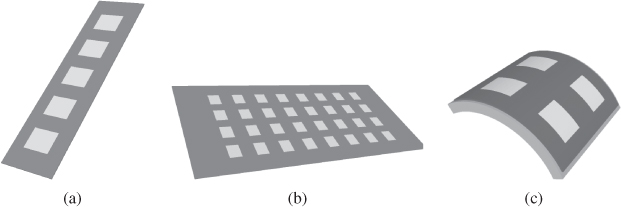7.6 Antenna Arrays
7.6.1 Single Element Radiation Pattern and Array Factor
An antenna array consists of multiple (in most cases identical) single antenna elements, for example dipoles or patch antennas. The individual elements are arranged in a line, distributed in a plane or placed on a curved surface, for example to conform with the surface of a vehicle or aircraft (Figure 7.22). The radiating fields of the individual elements superimpose and contribute to the radiation pattern of the antenna array. With special excitation schemes (variations of amplitude and phase of different elements) the radiation pattern of the array antenna can be shaped and the main lobe can be steered in different directions.
Figure 7.22 Array antenna with rectangular patch elements (a) arranged in a line, (b) distributed in a plane and (c) placed on a curved surface.

We will investigate the effect of combining single antennas into an array by looking at the following example of stacked dipoles. Figure 7.23 shows a series of radiation patterns for antenna arrays with two to five equally spaced half-wave dipoles (N ∈ {2, …, 5}). The distance between the vertically arranged dipoles is 82% of the free space wavelength (d = 0.82λ). All elements are excited with the same amplitude and phase. A single dipole (N = 1) exhibits the radiation pattern that we have already discussed in Section 7.4. With an increasing ...
Get RF and Microwave Engineering: Fundamentals of Wireless Communications now with the O’Reilly learning platform.
O’Reilly members experience books, live events, courses curated by job role, and more from O’Reilly and nearly 200 top publishers.

